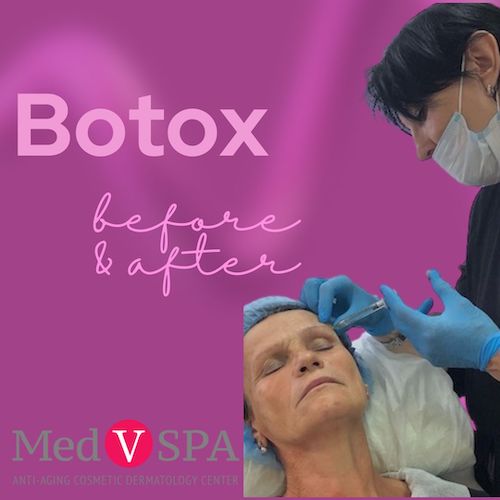Botox Before and After.

We're here with a new blog post to chat about life before and after Botox injections. As your go-to medical spa for women aged 45 and up, we get that Botox can sometimes bring up questions and uncertainties. In this post, we will talk about what you can expect before and after your Botox treatment. We understand that it can be confusing to differentiate between normal reactions and worrisome symptoms, so we are here to help. We will also let you know when to contact us for assistance and when things will settle down. Plus, we emphasize the importance of scheduling a follow-up appointment two weeks after your Botox session to ensure that you are happy with your results and feeling great. So, sit tight and join us on your post-Botox journey!
This article aims to help you understand Botox treatment better and ease your worries. After reading this, you'll know which symptoms or concerns after getting Botox, like Botox Brow Lift, Crow's Feet Botox, Chin Botox, or Full Face Botox, are legit and which are just caused by anxiety (which, by the way, hasn't been reported!). We'll also chat about which side effects to flag right away and which might sort themselves out. Plus, we'll talk about when it's time to check in with your injector to review your results and why your experience after one Botox session might differ from the past.
This article is based on the official "Botox Cosmetic Product monograph" published by Allergan. The information shared here is rooted in scientific research, including pharmaceutical studies, clinical trials, and detailed pharmacology and toxicology.
Marina Vashkevich, R.N., has simplified this scientific information to make it easy to understand. So, you can trust that the facts you're getting are backed by solid research and expert knowledge. If you have any concerns, email me at info@medvspa.com. I'll respond within a day to help.
How Does Botox Really Work?
When a small amount of purified botulinum toxin (BOTOX) is injected into a muscle, it temporarily weakens that muscle. This muscle weakness typically appears after 3-4 days and can last around four months but may vary. Evaluating the treatment results between 2-3 weeks after the Botox injections is best.
You don't need more frequent injections than once every 3 months because BOTOX COSMETIC® can smooth out facial lines for up to 120 days.
What Should I Not Do After Botox?
After receiving Botox injections, your ability to move the treated muscle may be limited temporarily, but it will gradually return to normal over time. You may need additional treatment later on. If you have concerns about the duration of your treatment, you should speak with your Botox provider.
Botox consent form emphasizes your attention to these crucial factors:
- You should stay upright and avoid touching the injection area for at least four hours after the injections to get the best results.
- To help Botox treatment work better, you should contact the treated muscles for about an hour.
Who Should Not Get Botox?
By signing the Botox consent form, you confirm that you are a suitable candidate for Botox treatment on your forehead, crow's feet, chin, and full face.
You understand that Botox should not be used if:
- You are allergic to BOTOX COSMETIC®.
- You have an infection at the injection site.
- You are having surgery with general anesthesia, taking or may take antibiotics.
- You are pregnant, might become pregnant, or nursing.
What Can Go Wrong with Botox?
After the injection, you may experience:
- pain,
- inflammation,
- numbness,
- swelling,
- infection,
- bleeding,
- bruising.
What Is the Biggest Risk of Botox?
The possibility of experiencing allergic reactions is the most serious. The most common allergic reaction symptoms are:
- an altered heart rate,
- chest pain,
- skin rash,
- other allergy symptoms.
How Do You Know if Botox Has Gone Wrong?
Other side effects reported after Botox injections include:
- headache,
- eyelid swelling,
- forehead numbness,
- drooping eyelids,
- temporary changes in facial shape
- double vision,
- an uneven smile.
Is It Possible to Be Resistant to Botox?
Possible reasons for lack of response to BOTOX COSMETIC® treatment include issues like not using the right dose, selecting the wrong muscles for injection, inaccessible muscles, structural abnormalities, changes in muscle patterns, patient expectations, improper storage, or the presence of neutralizing antibodies.
When our body detects toxins, it produces neutralizing antibodies to combat them. These antibodies can render the toxin inactive, preventing it from causing harm. However, if injections are administered too frequently, the body may start producing these antibodies even without toxins. It can make the antibodies less effective when they are needed. Therefore, avoiding frequent injections, with a gap of at least three months between them, is recommended to prevent the formation of neutralizing antibodies.
What Stops Botox From Working?
Neutralizing antibodies to botulinum toxin type A can reduce the effectiveness of BOTOX COSMETIC®. Studies suggest frequent injections or higher doses may lead to more antibody formation. To lower this risk:
- Start with the lowest dose and increase gradually if needed.
- Don't have injections more often than every three months.
What to Expect After Getting Botox?
The effect of Botox can differ from one treatment to another and even vary within an individual. For the most accurate assessment of Botox results, waiting at least two weeks after treatment is recommended before making any evaluations.
What Are the Side Effects With Botox?
In summary, although there are potential issues with Botox injections, it's essential to differentiate between legitimate worries and exaggerated fears. Get a professional assessment at a trusted medical office to address any uncertainties. Compare photos and videos to see the real results of Botox treatments and make an informed decision. Always prioritize your safety and well-being when considering Botox injections.
Treatments
- Botox
- Injections
- Facelift
- Eye Lift





